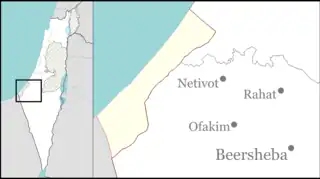Tkuma
תקומה | |
|---|---|
 Village synagogue | |
 Tkuma  Tkuma | |
| Coordinates: 31°26′56″N 34°34′39″E / 31.448751°N 34.577422°E | |
| Country | Israel |
| District | Southern |
| Council | Sdot Negev |
| Affiliation | Hapoel HaMizrachi |
| Founded | 5–6 October 1946 |
| Founded by | Eastern European Jews |
| Population (2021)[1] | 737 |
Tkuma (Hebrew: תְּקוּמָה, lit. 'Resurrection') is a religious moshav in southern Israel. Located north-west of Netivot, it falls under the jurisdiction of Sdot Negev Regional Council. In 2021 it had a population of 737.[1]
History
Tkuma was established as a kibbutz on the night of 5 and 6 October 1946 as one of the 11 points in the Negev at a location around a mile from the present site. The first residents were Jewish immigrants from Eastern Europe, who survived the Holocaust, and the village's name reflects the resurrection of Israel.
In 1949 the village moved to its present location near the site of the depopulated Arab village of al-Muharraqa. Scholar Benny Morris documents that Tkuma is near the al-Muharraqa site, but writer Walid Khalidi says that Tkuma, although only 2 km west of the al-Muharraqa site, is on land which once belonged to the city of Gaza.[2][3]
In the 1950s the moshav was joined by more immigrants from Eastern Europe and Tunisia.
Located 5 kilometers from Gaza, the moshav has suffered damage from rockets launched by Hamas militants during 2000s and 2010s. The moshav is serviced by the Color Red alert system.[4]

Economy
Since the 1990s, fish-farming has been an important economic branch. The sale of fresh fish to banquet halls and restaurants in the northern Negev has provided income for several families.[5]
References
- 1 2 "Regional Statistics". Israel Central Bureau of Statistics. Retrieved 22 February 2023.
- ↑ Morris, Benny (2004). The Birth of the Palestinian Refugee Problem Revisited. Cambridge: Cambridge University Press. p. xxi. ISBN 978-0-521-00967-6.
- ↑ Khalidi, Walid (1992), All That Remains: The Palestinian Villages Occupied and Depopulated by Israel in 1948, Washington D.C.: Institute for Palestine Studies, p. 127, ISBN 0-88728-224-5
- ↑ Kershner, Isabel (December 24, 2008). "Gaza Rocket Fire Intensifies". The New York Times. Retrieved April 17, 2019.
- ↑ Heruti-Sover, Tali (January 18, 2009). "Gaza War Leads to Creative Marketing and Success". Haaretz. Retrieved April 17, 2019.
External links
- Tkuma Negev Information Centre